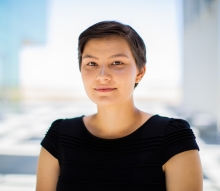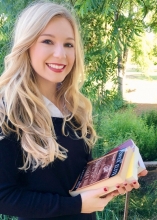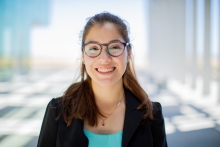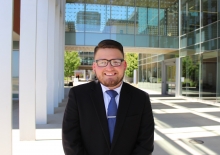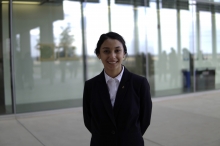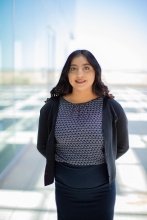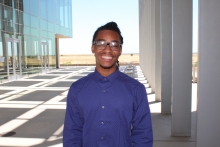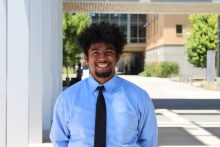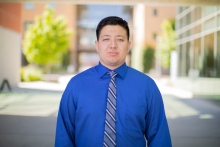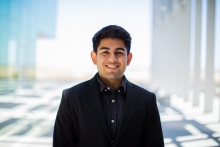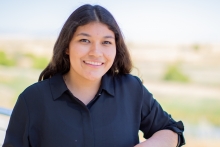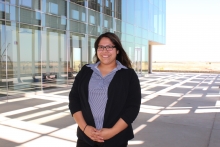Jocelyn Acosta
Jocelyn Acosta is a third year undergraduate from Sacramento, CA and is expected to graduate in Spring 2020 with a BA in Public Health and a minor in Professional Writing. Jocelyn is currently employed as a cashier for University of California Merced's Recreation and Athletics Department. As a representative of the student body, she is highly interested in business management and likes to focus her enthusiasm towards organizations on campus that are related to her current passions in health and community involvement. Jocelyn seeks to continue higher education by striving for her Master's as she begins her journey by participating in faculty-mentored research.
The Diversity and Vector Potential of Merced County Mosquitoes
Jocelyn Acosta, Eunis Hernandez, Ryan Torres, and Andrea Joyce, PhD; School of Social Sciences, Humanities, and Arts, University of California, Merced
This project examines the diversity of mosquitoes in Merced County by evaluating the ecology of 11 different mosquito species and by identifying their vector potential to transmit various diseases. Currently, there is no guide to specifically identify the mosquitoes that are found in Merced County and their vector potential to transmit multiple diseases. Analyzing the various mosquito types in Merced and categorizing the habitats each mosquito is found in will provide information for the public and contribute to the public health of Merced County. This project will survey different habitats that could be potential breeding sites for different mosquitoes. The EVS mosquito trap which uses CO2 and an attached light source will be used to attract mosquitoes. The collection sites will be mapped. Mosquitoes that are trapped will be identified according to species. From each collection site, the proportion of each mosquito species will be determined. In addition, literature has been reviewed to determine the vector potential of each mosquito. By determining the diversity of mosquitoes in different habitats in Merced County, a field guide can be produced in order to interpret the significance of vector control as well as provide a summarized review of different mosquito types and their ability to transmit disease. With the risk of mosquito-borne diseases, it is important to investigate the mosquito populations found within Merced County.
Israel Alberto
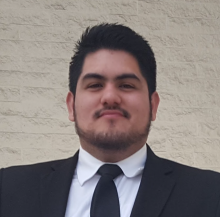 |
Major: Mechanical Engineering
Home City: Modesto, CA
Contact: ialberto@ucmerced.edu
Faculty Mentor: Yue Jessica Wang
|
Israel Alberto is a fourth-year undergraduate student who is pursuing a BS in Mechanical Engineering. He is expected to graduate in Fall 2019. Although his name is Israel , many call him Izzy. He is a member of Fiat Lux and Ingenieros Unidos at UC Merced. Izzy hopes to make a contribution to the community by conducting research . He will be doing research that touches base on wearable electronics. During his free time, Izzy takes joy making melted crayon art because he believes you can never make a mistake when trying it. One day Izzy would like to have a career where he will help others by assembling prosthetic limbs. He hopes to be an inspiration to those who have been disadvantaged so they can succeed and pursue higher education.
3D Printable Conducting Polymers for Wearable Electronics
Israel Alberto, Ian Hill, Victor Hernandez, and Yue (Jessica) Wang, PhD; School of Engineering, University of California, Merced
Wearable electronics require conformability to the human body, with matching stiffness as the skin and must be able to stretch to accommodate body movement. Metals are the most commonly used electrically conducting material for these applications. A major drawback using metal conductors is their inability to withstand high strain without losing conductivity. Metal conductors are also difficult to recover and recycle. To address these issues, we have developed a conductive polymer composite that is able to withstand high strain while maintaining its conductivity, and is easy to recycle, requiring only water. Our composite contains polyaniline doped with poly(2-acrylamido-2-methyl-1-propane sulfonic acid) to increase ductility, poly 3,4-ethylenedioxythiophene:poly(styrene sulfonate) to increase electrical conductivity, and an ionic liquid as a plasticizer and dopant. Pastes can undergo elongation up to 250% and has an electrical resistance of 7 Ω. These composites can be easily recycled and reprocessed in water, then 3D printed into customizable circuits or flexible electronic devices using a direct write assembly technique.
Mohammed Amwas
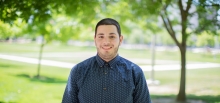 |
Major: Bioengineering
Home City: Riverside, CA
Contact: mamwas@ucmerced.edu
Faculty Mentor: Kara McCloskey
|
Mohammed Amawas is a fifth-year undergraduate student from Riverside, California. Expected to graduate in Spring 2019 with a BS in Bioengineering, he aspires to receive a Ph.D. in the field of biomedical engineering with the goal of doing biomedical research in an institutional or national laboratory. During his time at the University of California, Merced, Mohammed has been a very active member by serving as the Intellectual Property Officer for the Engineering Service Learning Unmanned Aerial Vehicle team and being involved in the Biomedical Engineering Society (BMES). Mohammed enjoys networking and meeting new people. During his free time, he travels around the United States and goes on international trips to explore new places and cultures.
Establishing Ex-Vivo Model System for Studying Cardiac Repair Mechanisms in Regenerative Medicine
Mohammed Amwas, Anley Tefera, MS, and Kara McCloskey, PhD; School of Engineering, University of California, Merced
One in every four deaths in the U.S. is caused by cardiac diseases. A main focus in cardiac research is developing model systems for studying cardiac repair mechanisms and pathology. Myocardial tissue slices provide a multicellular and functionally intact ex-vivo model system for cardiac research. Tissue slices are usually produced with a thickness of 100-400 μm, allowing the diffusion of oxygen and metabolic substrates to maintain their viability. However, due to the lack of mechanical loading and electric stimulation in cultured myocardial tissue slices, cardiomyocytes tend to remodel and lose their contractility, starting in their first day in culture. We plan to establish methods for preparing highly viable porcine myocardial tissue slices and maintaining their viability and functionality over long period that can extend to months. Applying mechanical stimulation on the tissue slices allows them to maintain their viability and functionality over longer time. We obtained a pig’s heart from a slaughterhouse and cut 400-500 μm thick myocardial tissue slices using Leica VT1000 S microtome. The tissue slices are cultured on a liquid-air interface. The slices will be loaded in a device that provides cyclic biaxial mechanical stimulation during the culturing period. We expect superior viability and functionality in the loaded tissue slices. The viability and functionality of the cardiomyocytes are tested using viability staining and calcium transient testing, respectively.
Julia Beale
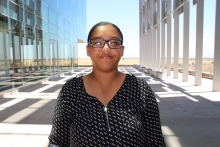 |
Major: Applied Mathematics
Home City: Merced, CA
Contact: jbeale@ucmerced.edu
Faculty Mentor: Jennifer Manilay
|
Julia Beale is going to be a third-year undergraduate, whose hometown is Merced, CA. She plans to graduate from the University of California, Merced in 2020 with a BS in Applied Mathematics. While at UC Merced, Julia has pursued various different job opportunities, including a job with the Gateway Scholars Program and a job as a substitute instructional aide for special education with the Merced County Office of Education. Eventually, she intends to attend graduate school and get a PhD within the field of computational biology. Throughout her spare time, Julia likes to visit museums and read. When Julia is not doing these activities, she enjoys participating in community service.
Identifying Natural Killer Ly49 Clusters Post Tumor Cell Killing
Julia Beale, Alberto J. Millan, and Jennifer Manilay, PhD; School of Natural Sciences, University of California, Merced
Natural Killer (NK) cells are innate immune lymphocytes that kill virally infected and cancerous cells, by releasing perforin and granzymes. NK cells express Ly49 surface receptors, which are involved in distinguishing healthy from unhealthy cells. The “Summation Hypothesis” suggests that the sum of NK cell intrinsic signals, upon engagement of Ly49 activating and inhibitory receptors will dictate killing of a potential target by the NK cell. Despite Ly49 receptors’ known role in controlling NK cell activity, the Ly49 receptor combination leading to optimal target cell killing is unclear. We developed a computational approach to identify clusters (populations) of WT NK cells with differences in expression of activating Ly49H and Ly49D and inhibitory Ly49I and Ly49G2 receptors in the presence and absence of β2m -/- cell targets. Using viSNE, a high-dimensional data reduction algorithm, we identified 10 distinct clusters with varying Ly49 receptors and frequencies. We found a significantly increased frequency of NK cells with a Ly49H- Ly49D- Ly49G2 - Ly49I -/+ profile in the presence of targets. Alternatively, NK cells with a Ly49H+ D+ G2+ I-/+profile were significantly reduced, surprisingly indicating a lack of target cell killing associated with this profile. This unbiased approach should help identify NK cells expressing the ideal Ly49 receptor repertoire for killing cancerous cells, and has possible applications in NK cell cancer immunotherapies.
Javier Chaname
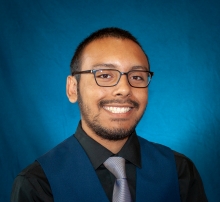 |
Major: Environmental Engineering
Home City: Tracy, CA
Contact: jchaname@ucmerced.edu
Faculty Mentor: Sarah Kurtz
|
Javier Chaname is an upcoming fourth year undergraduate student at the University of California, Merced. He is expected to graduate in Fall of 2019 with a BS in Environmental Engineering. Javier began as a Success Mentor for the Success Mentor Program for his second and third year, believing that inspiring younger students to reach their full potential will be beneficial for the world. He also founded his interest in solar energy by writing and publishing a research paper in the URJ during his freshman year of college. In addition, Javier joined UC Solar to get experience in research within the field of solar energy. He assisted graduate students develop and build and hybrid PV-CPC solar pipe that would absorb thermal energy and electricity from the sun. To destress, Javier often takes trips to Yosemite, listens to music and watch movies. Furthermore, Javier aspires to work and do research within the solar energy field as he believes it is a viable energy source that can be improved to replace of fossil fuels altogether.
Testing Solar Modules for use in AIPV Applications
Javier Chaname, Aaron Wheeler, and Sarah Kurtz, PhD; School of Engineering, University of California, Merced
Solar powered cars are a sustainable alternative to gas powered cars, but there have been many problems with implementing the solar panel in a car in a practical way. We want to understand the performances of a variety of solar modules on a car roof or variety of environments. We tested Gallium Arsenide solar modules side by side with silicon solar modules by laying them on a black box, simulating the roof of a car, and see which solar module would be ideal to place in a car. Temperature and power output of the solar modules as well as environmental conditions will be collected. We aim to quantify the performance of various solar modules as a function of operating conditions.
Gloria Chavez
Gloria Chavez is a fourth-year Public Health major from Visalia, CA. She has been involved in various research opportunities on campus. Most notably, Gloria has had the opportunity to present her research at the Association for Psychological Science (APS) Conference this past May as a health psychology research assistant. Some of Gloria's research interests include sexual risky behaviors, substance use and the management of chronic conditions. In her free time, Gloria enjoys spending quality time with her pets and her boyfriend, Julio. Gloria aspires to complete her PhD in Public Health or Health Psychology. She is planning on furthering her education to acquire necessary knowledge to implement public health programs serving low income communities.
Social Relationships and Type 1 Diabetes Management in Early Emerging Adulthood: Help or Hinderance?
Gloria Chavez, Avia Gray, MA, and Deborah Wiebe, PhD; School of Social Sciences, Humanities, and Arts, University of California, Merced
Early emerging adulthood (ages 18-25) is the time of development when Type 1 diabetes management (T1DM) is the poorest. It is theorized that this may reflect various social transitions and changing social resources at this time of life (e.g., moving away from parents; managing T1D in new academic and professional environments). However, little is known about the social contexts that help or hinder T1DM at this high risk time. The present pilot study had 29 emerging adults with T1D complete a survey and qualitative interview. Parents and romantic partners were the most trusted social resources with 59% stating parents and 35% stating partners are most counted on for help with T1DM. Parents (48%) and partners (24%) were also the most common sources of criticism, while friends (31%) and parents (17%) made T1DM more difficult. Thematic coding of the qualitative interviews is in progress to understand how parents, partners and peers may help (e.g., provide reminders, emotional and instrumental support) or hinder T1DM (e.g., over-react; offer unhealthy foods; distract from T1DM), and how emerging adults may better utilize their social resources (e.g., disclose about T1DM to solicit help when needed. Findings may identify factors that can guide interventions to better support T1DM in early emerging adulthood.
Mugdha Dhungana
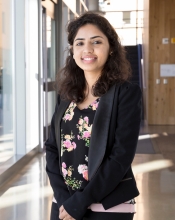 |
Major:
Home City:
Contact:
Faculty Mentor:
|
Collaborative Childcare with Privacy Protection
Mugdha Dhungana, Stephanie J. Dube, M. Lisa Yeo, PhD; School of Engineering, University of California, Merced
Childcare services are difficult to obtain for UC Merced affiliates; an app to help connect people has been proposed as one way to alleviate these pressures and enable sharing of both child related goods and services. We are interested in understanding the privacy and security concerns of individuals who may benefit from this application, so that we can incorporate protections during application development. We believe that users will be more concerned about privacy protections in the context of childcare than they would be with the sharing of household goods and services. Interviews of parents and caregivers were used to get an initial state of privacy concerns for the application and text analysis. Based on the text analysis, we develop a journey map that will showcase the user interface and help understand the functionality and usage of the app. We have analyzed the various user needs and implemented it into the journey map along with the security and privacy considerations. The journey map will allow for better understanding of the application development. We will collect application usage data to examine patterns of behavior to see how various demographic factors affect parents’ safety priorities.
Huong Do
 |
Major: Chemical Sciences
Home City: Los Angeles, CA
Contact: hdo8@ucmerced.edu
Faculty Mentor: Ben Stokes
|
Huong Do is a second-year undergraduate student from Los Angeles, CA. Expected to graduate in Spring 2020 with a BS in Chemical Science. Huong knows how hard it is to attend college and try her best to fulfill her dream goal. Huong is planning to attend graduate school with the aspiration of doing research and attain a Ph.D. in the chemistry field. Her ultimate dream goal is to become a pharmaceutical scientist that could inspire and motivate young women to pursue higher education in the science field. To destress, Huong enjoys exploring new things, reading, and loves to travel to different places to learn more about other cultures and lifestyles. As a member of Alpha Pregnancy Help Club, Huong wants to contribute her best to the community by volunteering and advocating her influential support to make a better change for the students and community.
Ethers as H Atom Donors in Palladium-Catalyzed Transfer Hydrogenations Mediated by Tetrahydroxydiaborane
Huong Do, Jocelyn Ochoa, Ixchel B. Gonzalez, and Benjamin J. Stokes, PhD; School of Natural Sciences, University of California, Merced
Transition metal-catalyzed transfer hydrogenation is commonly used to reduce functional groups in organic molecules. We previously reported a method to reduce alkenes and alkynes using stoichiometric water and tetrahydroxydiborane at ambient temperature and pressure. In the course of these studies, we found that tetrahydrofuran (THF) can also serve as an H atom donor under similar conditions. The stoichiometric use of ethers as a metal hydride source is not well established, and would permit a safe and simple hydrogenation method compared to direct hydrogenation with hydrogen gas. Such a method could also be used to reduce water-sensitive compounds. Our efforts to optimize, evaluate the breadth, and understand the mechanism of this reaction are described below.
Stephanie Dube
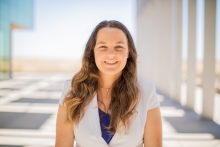 |
Major: Computer Science & Engineering
Home City: Riverside, CA
Contact: sdube@ucmerced.edu
Faculty Mentor: Lisa Yeo
|
Stephanie Dubé is currently completing her Bachelor's degree at the University of California-Merced, majoring in Computer Science and Engineering. With her expected graduation in Spring 2019, she is currently focusing on computer software development with emphasis on data privacy engineering. Stephanie is passionate about making an impact on consumer data practices through innovative thinking and balancing consumer expectations with a constantly changing world. In her spare time, she enjoys gaming and reading sci-fi books.
Collaborative Childcare: Identifying Priorities
Stephanie Dube, Mugdha Dhungana, and Lisa Yeo, PhD; School of Engineering, University of California, Merced
Childcare services are difficult to obtain for UC Merced affiliates; an app to help connect people has been proposed as one way to alleviate these pressures and enable sharing of both child related goods and services. We are interested in understanding the privacy and security concerns of individuals who may benefit from this application, so that we can incorporate protections during application development. We believe that users will be more concerned about privacy protections in the context of childcare than they would be with the sharing of household goods and services. Interviews of parents and caregivers were used to get an initial state of privacy concerns for the application and text analysis. Using NVivo we analyzed the qualitative data to identify themes for application development and that of people's privacy and security concerns while examining correlations between users concerns and their demographics. This information will serve as the foundation to create the journey map for the application development. We will collect application data to examine behavioral and security patterns as part of a longer-term study.
Emily Fishburn
Emily Fishburn is currently entering her fourth year as an undergraduate student at the University of California, Merced and is expected to graduate in Fall 2018 with a B.A. in Sociology and a minor in Political Science. While attending the university, Emily has performed in UC Merced's first original production of "Shakespeare in Yosemite", volunteered for UC Merced's Early Childhood Education Center (ECEC), attended various leadership conferences, and volunteered for a non-profit organization serving U.S. veterans. More recently, Emily was inducted into UC Merced's inaugural chapter of Alpha Kappa Delta: The International Honor Society of Sociology. Following her upcoming graduation from UC Merced, Emily plans to attend graduate school for both an M.S.W. and a Ph.D. in Sociology.
Political Framing (Without) Effects: An Optimistic Reconsideration of Rationality and Democratic Competence Using Equivalency Frames
Emily Fishburn, and Stephen Nicholson, PhD; School of Social Sciences, Humanities, and Arts, University of California, Merced
The literature surrounding “framing effects” has cultivated interest in the fields of sociology, psychology, and political science. According to the works of both political scientists and political psychologists, “framing effects” can reveal the way in which cognitive biases lead individuals to systematically judge certain political options as more favorable (if they were presented positively) than other logically equivalent options (if they were presented negatively). These appropriately named “equivalency frames” are often presented in terms of either perceived “gains” or “losses”. Existing work suggests that individuals will make risk-averse choices in response to the perceived assurance of gains and, conversely, display risk-seeking behavior in response to perceived losses. In this experiment, three equivalently framed questions regarding “economic inequality” and “economic equality” were delivered in a survey to nearly 1,000 participants using the online survey platform, QualTrics, and Survey Sampling International (SSI). Using the Statistical Package for the Social Sciences (SPSS), responses were analyzed to determine the strength of frames and the potential significance of respondent party identification. Neither framed “losses” nor “gains” presented any statistically significant effects on respondents. These results are inconsistent with the bulk of prior research, suggesting that either the influence of these frames were not as strong as others, or perhaps individuals are not as susceptible to the influence of framing as previously thought.
Jocelyn Galdamez-Melendez
Jocelyn Galdamez-Melendez, from San Jose, CA, will be a fourth-year undergraduate student at University of California, Merced and is expected to graduate in Spring 2019. She is currently pursuing a Bachelor's of Art in Sociology with a minor in Anthropology. Jocelyn is a member of the Sociology Club and was a Residential Assistant during her second and third year. Jocelyn is pleased to participate in the Summer Research Fellowship because it is another great opportunity for her to work with a professor and get more hands-on experience in the Sociological field. Jocelyn will be studying abroad in Fall 2018 in the program of Human Right and Cultural Memory in Buenos Aires, Argentina and Santiago, Chile. One of her biggest life accomplishments is being able to travel the world and learn at the same time. By studying abroad, Jocelyn will be able to seize the opportunities that are given to her at UC Merced and live out her accomplishment. In her free time, Jocelyn likes to read for pleasure and volunteer because she thinks it is important to give back to her community, and travels when she can. Jocelyn has previously traveled to Costa Rica and Europe where she went to a couple countries including, England, France, Spain, etc. She enjoys going on hikes and attending concerts. Jocelyn aspires to continue her higher education and attend graduate school and be a future role model to others, especially those of the first generation population.
How Student Learning Preference Affect Learning Outcomes
Jocelyn Galdamez-Melendez, Maria D. Dueñas, MA, and Tanya Golash Boza, PhD; School of Social Science, Humanities, and Arts, University of California, Merced
This research aims to study the effectiveness of videos on learning on race and racism and how students’ preferences affect learning outcomes. Previous research has found that students have learning preferences that allow them to better understand new concepts. Perceived learning preferences shape video-and text- based learning outcomes because students understand and obtain more information when their learning preference is incorporated into the classroom. Two groups were tested in this study. One group was tested through the use of a video and the other group was tested through reading the script of the video screening. Students were asked to answer questions to measure how well they understood the material discussed in the video or script. Both groups were asked about their learning preference: learning through videos, learning through readings, a combination of both, or other. The results showed that 65.9 % of students preferred the combination of both text and video. 54.5% of students scored higher using text compared to 45.5% of students watching the video. These results suggest that videos which incorporate text would allow students to better comprehend course material by exposing students to both text and visual learning styles. These results coincide with previous studies done. Students learn more when their learning preference is taken into consideration.
Fatima Gamino
 |
Major: Environmental Engineering
Home City: Firebaugh, CA
Contact: fgamino@ucmerced.edu
Faculty Mentor: Rebecca Ryals
|
Fatima Gamino is a Central Valley native raised in Firebaugh, California. She is pursuing a degree in Environmental Engineering and is expected to graduate in Spring 2020. Fatima is an active member of Ingenieros Unidos, the Merced Chapter of the Society of Hispanic Engineers. She is greatly involved in the local community by mentoring high school students and volunteering in programs that encourage students to pursue a degree in STEM. Fatima is passionate about sustainability and raising awareness in taking care of the environment. When not focused on her academics, she enjoys exploring different places or simply going out to get iced coffee. Fatima hopes to continue undergraduate research and make an impact at UC Merced. Afterwards, she aspires to pursue a graduate education in Civil Engineering or Environmental Systems.
The Effects of Biosolids on Plant Growth and Water Quality in Merced County
Fatima Gamino1, Yocelyn Villa1, and Rebecca Ryals, PhD2; School of Engineering, University of California, Merced1; School of Natural Sciences, University of California, Merced2
Efficient nutrient cycling in agricultural systems is associated with improved carbon storage, reduced leaching, and improved yields. Soil organic matter is the driving force of nutrient management in a sustainable agroecosystem. Biosolids are a nutrient-rich form of organic matter produced during the treatment of municipal wastewater. Our objectives were to determine short- and long-term effects of biosolids amendments on nutrient loss to water. In this experiment, soil samples were collected to a depth of 10 cm from a ranch in Merced County. The site includes an agricultural field that has been treated with biosolids for 20 years and an untreated control area. Barley was grown in six treatments which included: the control and long-term treated soils, as well as both with added composted biosolids, and both with added fresh biosolids. The incubation included weekly irrigation events to test for loss of nutrients (nitrate, ammonium, and phosphate) through leaching. Effectiveness of biosolids amendment on plant growth was determined by plant height in each of the samples. The presence of composted biosolids in the samples was shown to increase the soil water-holding capacity. These results suggest that a sustainable approach to agriculture through the addition of organic matter, like biosolids, increases plant yields while minimizing nutrient losses to groundwater.
Brian Hoang
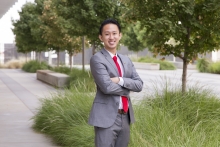 |
Major: Bioengineering
Home City: Stockton, CA
Contact: bhoang7@ucmerced.edu
Faculty Mentor: Andy LiWang
|
Brian Hoang is an upcoming fifth-year undergraduate student from Stockton, CA. Expected to graduate in Fall 2018 with a BS in Bioengineering, he aspires to obtain a Ph.D. in a Bioengineering graduate program upon finishing undergrad. His ultimate goal is to work in the biotechnology industry where he can apply his skills and experiences in ways that will help benefit society. He is a part of several organizations on campus, including Pi Lambda Phi Fraternity and Biomedical Engineering Society. Being a part of these organizations has taught him to become more involved with the community around him and to pursue passionate opportunities and goals given to him. In his free time, Brian enjoys listening to music and going on adventures with friends.
Alteration of the Alpha-5 Helix Affect KaiA-KaiB-KaiC Cooperative Interactions in the Circadian Clock of Cyanobacteria
Brian Hoang, Archana Chavan, Xuejun Yao, and Andy LiWang, PhD; School of Natural Sciences, University of California, Merced
The circadian oscillator in cyanobacteria is generated by the interaction of three proteins: KaiA, KaiB, and KaiC. Together, these proteins generate a 24-hour rhythm of KaiC phosphorylation, which is stimulated by KaiA during the day and is inactivated by KaiB at night producing a synchronized phosphorylation rhythm. The α5 - helix connecting the N- and C-terminal domains of KaiA was previously believed to act as a linker region that did not play a role in generating circadian rhythm. However, it has been revealed that KaiA undergoes a large conformational change from its active (day) to inactive state (night), which involves the displacement of the α5-helix from N-terminal to C-terminal domain. We hypothesize that the binding affinity of the α5-helix to its N- and C-terminal domains change as a function of temperature, thereby regulating the active and inactive states of KaiA in an oscillating reaction. To understand how the α5 - helix binds to the N- and C- terminal domains of KaiA, we isolated and cloned the α5 - helix in order to mutate residue 156 from leucine (L) to alanine (A). This mutation has been shown to weaken its interaction with KaiA’s C-terminal domain. We will be using fluorescence polarization experiments to measure binding affinities of the wild-type and mutant peptide to KaiA’s N- and C-terminal domains at various temperatures.
Shawn Ignacio
Shawn Ignacio is a fourth-year undergraduate student originally from Sacramento, CA. He is expected to graduate in Spring 2019 with a BS in Biology. In addition to conducting research, Shawn has been involved in various campus organizations such as: Circle K, Fiat Lux, Global Brigades, Pilipino American Alliance, Pre-Pharmacy Club, Medical-Cats, and AMSA. Thanks to the diverse experience learned from the organizations, he hopes to pursue a PhD in graduate school and continue his interest in contributing to the health field. Some of Shawn’s hobbies include cooking and reading.
Detecting Inflammation in Hematopoietic Stem Cells in a Sclerostin Deficient Microenvironment
Shawn Ignacio, Cristine Donham, and Jennifer O. Manilay, PhD; School of Natural Sciences, University of California, Merced
Sclerostin (Sost) is a protein secreted predominantly by osteocytes that inhibits bone formation by blocking Wnt/β-catenin signaling and activation of osteoblast function. The loss of sclerostin results in increased bone formation. As Wnt signaling is also important for hematopoietic stem cell (HSC) maintenance and self- renewal, we hypothesized that the loss of Sost in the bone microenvironment would influence HSC fate. Our studies indicate that loss of Sost in the bone microenvironment induces a myeloid bias in downstream production of progenitors. This increase in the myeloid lineages is indicative of inflammation, the rapid immune response to cellular damage, in upstream hematopoiesis. Our goal is to confirm if inflammation is present in a sclerostin-deficient bone marrow environment and understand how it affects hematopoietic stem cells. Using both wild type (WT) and sclerostin knockout (SostKO) mice, we quantified the expression of known inflammatory genes Pu.1, Cebpβ, and Batf2 by using qPCR. We hypothesize that increased expression of these genes will correlate with hematopoietic inflammation in a sclerostin-deficient microenvironment.
Salvador Lopez
Salvador Lopez is a fourth-year undergraduate student from Planada, CA. Expected to graduate in Spring 2019 with a BA in Public Health. In the near future, Salvador aspires to enroll in a joint MD/PhD program to continue research in public health and help others that lack access to resources and medical care. As a first-generation college student he wishes to inspire others to pursue a degree in higher education. On campus, Salvador works for the Office of Financial Aid & Scholarships, Recreation & Athletics, and is part of the Public Health Society and currently serves as the Vice President for Delta Epsilon Mu Fraternity. During his spare time he enjoys going out with his friends, painting, taking pictures, and going to professional conferences.
Pesticide and Acute Asthma Attacks in California, USA in 2005 to 2008: A Bidirectional Symmetric Case Crossover Study
Salvador Lopez, Hamed Gharibi, MS, and Ricardo Cisneros, PhD; School of Social Sciences, Humanities, and Arts, University of California, Merced
California is the leading producer of agricultural commodities. In 2015, 213 million pounds of pesticides were reported to be used in the agriculture industry. Previous research has shown that inhalation of pesticides has been linked with respiratory diseases. Two of the most used pesticides in California are methyl bromide (MeBR) and 1, 3-dichloroprophene (1,3-DCP). These two pollutants have been speculated to cause respiratory disease, therefore we hypothesize that they have the ability to act as intense asthma triggers. In this study, a bidirectional symmetric case-crossover method was applied to examine the data obtained from Emergency Department visits for asthma occurrence and EPA emissions data for methyl bromide and 1,3-DCP within the study area. We observed that the odds ratio for MBR and CDCP are positively associated with the asthma ED visits only in the cold seasons. We also found a positive association between MBR and CDCP and asthma ED visits among African Americans and Hispanics. Further research is needed to address the effects of pesticides on our health in order to implement policies on training, better air monitoring of toxic organic compounds, and resources for those affected.
Valerie Martinez
Valerie Martinez is a fourth-year undergraduate student from Livingston, CA. Expected to graduate in Spring 2019 with a BA in Psychology and a minor in Sociology. She aspires to receive a PhD in Health Psychology with the ultimate goal of becoming a researcher at a university. Valerie has already began to make her mark at UC Merced by being an active member in Alpha Kappa Psi and has previously assisted in researching sexual risk behaviors amongst adolescents for the Wallander Lab. Aside from doing research and being in a professional organization, she enjoys listening to modern classical music and going on hikes.
The Importance of having a Usual Source of Dental Care in Stanislaus and Madera County
Valerie Martinez1, Nancy Burke, PhD1,2, and Mariaelena Gonzalez, PhD1,2; School of Social Sciences, Humanities, and Arts, University of California, Merced1; Health Sciences Research Institute, University of California, Merced2
This research project examines access to usual sources of dental care and time since last dental visit in Madera and Stanislaus County, which are health provider shortage areas, and have a significant proportion of their population enrolled in Denti-Cal. 79 adult participants were recruited from June-July 2018. Demographic and oral health information was collected via a self-administered survey. Participants were asked “Do you have a dentist?” and “how long has it been since your last trip to the dentist?”. I triangulated our data against the California Health Interview Survey (CHIS). In Madera county 56.4% of respondents reported a usual source of care, while 53.9% reported having visited the dentist in the last year. In Stanislaus County 55.0% of respondents reported that they had a dentist, while 60% reported that they have visited the dentist within the past year. CHIS reported that 67.2% responded visited the dentist within the past year in Madera County and for Stanislaus County it was 62.7%. A higher percentage of respondents in both counties do not routinely visit the dentist or have a dental home. Both a usual source of care, and routine visits are needed for effective oral care.
Andrea Molina
Andrea Molina is a third-year undergraduate student from San Carlos, CA. She is expected to graduate in Spring 2020 with a BA in Sociology and a minor in Writing. Andrea is currently a law clerk at the UC Merced Law Clinic, a Student Cohort Leader for College Track, and a research assistant in the Sociology department. Her long term goal is to achieve a PhD in Sociology and inform social justice issues to students. On her free time, Andrea enjoys hiking and spending time with her family. She aspires to set an example for her two nieces by being the first girl in her family to go to college. Her main goal after graduation is to inspire minorities with similar ethnic backgrounds to pursue higher education.
How Effective Are Videos in Enhancing Student Learning Compared to Reading Text?
Andrea Molina, Maria Dueñas, MA, and Tonya Golash-Boza, PhD; School of Social Sciences, Humanities, and Arts, University of California, Merced
Previous research has shown that videos help students maintain engagement, while helping them retain information better through the use of video techniques such as signaling, segmenting, and weeding. Based on the prevailing literature, Andrea hypothesized that videos promote active learning compared to reading text. Andrea conducted her research study to assess the effectiveness of videos on learning about race and racism. The first group were tested through the use of reading a script based off of a video screening. The second group were tested through the use of a video. After students finished, they were asked to answer eight questions to measure how well they understood the material discussed in the script or video. She was able to compare both groups and determine which group understood the material better. The average score from the text group was 54.5%, compared to students from the video screening group who scored 45.5%. Students who watched the video screening did not understand the material as well as the students who read the script. Race and racism can be a difficult topic to understand through videos because it is a controversial topic. Videos may enhance student learning to an extent, but they have limitations. These limitations may be addressed through improving the videos. For example, signaling, segmenting, and weeding may enhance student learning.
David Olson
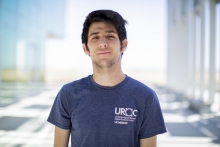 |
Major: Psychology
Home City: Lancaster, CA
Contact: dolson4@ucmerced.edu
Faculty Mentor: Jennifer Howell
|
David Olson is a fourth-year transfer student from Lancaster, CA. Receiving his A.A. in Psychology from Antelope Valley College in 2017, he is now pursuing a B.A. in Psychology at University of California, Merced. David currently is a research assistant in Merced’s Experimental Social and Health (M.E.S.H.) Psychology Laboratory studying the influence of self-efficacy on health information avoidance, the relationship between self-uncertainty and group normative behaviors, and implicit attitudes towards Latinx communities in the central valley of California. In his freetime, David enjoys music analysis, working on graphic design, and playing Super Smash Bros. Melee. After graduating, David wants to pursue a PhD in Social Psychology and become a professor at a university, with the goal of providing support to students to help them achieve their success.
Latin X Well-Being
David Olson, Jacqueline Hua, and Jennifer Howell, PhD; School of Social Sciences, Humanities, and Arts, University of California, Merced
Adjusting to college life is difficult but adjusting as a Latinx student appears to be even more challenging. Latinx students face unique challenges such as the cultural adjustment to their new environment. These unique challenges take their toll on the physical and social wellbeing of these students. One way to observe this cultural adjustment is to look at the social eating behaviors of the students in the dining halls of college campuses and examining correlations between social adjustment and whether these students were eating alone. Previous research has shown that eating alone is a predictor of depression amongst individuals. For this study, data was collected in a larger study investigating the relationship between acculturation and dietary intake. Participants were recruited from the Yablakoff-Wallace Dining Center at the University of California, Merced to complete two online surveys. The participants consisted of 76 undergraduates who were primarily female (51%), Latinx/Hispanic (67.6%), first-year students (47.5%), and an average age of 19.63 years old (SD = 2.02). This study found that being Latinx/Hispanic was a predictor of greater social support, but also worse physical health status along with a greater expectation that it will get worse over time. Latinx/Hispanic students seem to also make food decisions that are not beneficial to health, even though they believe that they are making healthy food choices. Future research should seek to answer or explain this phenomenon amongst Latinx/Hispanic students.
Dayvon Patterson
Dayvon Patterson is a fourth-year undergraduate student born in Oakland California. Dayvon is going to graduate spring of 2019 with a Bachelor’s of Science in Human Biology. He aspires to go the medical school and receive a medical degree and fulfill his lifelong dream to become a gastroenterologist. Dayvon was a resident assistant at University of California Merced for two years. Dayvon has also recently joined the phi lambda chapter of the professional medical fraternity Phi Delta Epsilon. Dayvon is passionate about furthering the development of students in low socio-economic communities, pursuing careers in health and medicine, and professional development.
Investigating the Role of Sept9a in Endoderm Formation
Dayvon Patterson, Kyle Shen, Stefan Materna, PhD, and Stephanie Woo, PhD; School of Natural Sciences, University of California, Merced
Congenital and inherited malformations of the digestive tract debilitate an organism’s ability to live and perform normal functions. The digestive tract is derived from an embryonic tissue called the endoderm. Previous results showed that the gene septin 9a (sept9a) is highly expressed during endoderm formation, however the contribution of sept9a to this process is unknown. Septins are cytoskeletal proteins that are found in the cell cortex where they function as scaffolds. Compared to other cytoskeletal proteins like actin and microtubules, little is known about septin function. We hypothesize that sept9a plays a critical function in endoderm morphogenesis and gut development. Here, we used CRISPR/Cas9 to create sept9a mutations in zebrafish in order to gain a better understanding of the gene’s role in endoderm formation. For our first approach, we used CRIPSR/Cas9 to create a large deletion in the sept9a gene. In a second approach, we used CRIPSR/Cas9 to knock-in a premature stop codon by homologous recombination. Utilizing genotyping methods, we have identified 10 F0 zebrafish carrying germ line transmission of sept9a mutations. We are currently raising offspring of some of these zebrafish. Future studies will determine if these mutant zebrafish have altered endoderm morphogenesis compared to wild type zebrafish. These studies will give us a greater understanding of both gut development and septin function.
Hawa Padmore
Hawa Padmore is a fourth year undergraduate student from Sacramento, CA. She is expected to graduate Spring 2019 with a Bachelors in Microbiology and Immunology. Hawa has a strong desire to expand her knowledge about cell biology by diving into research. Since the beginning of her college career, Hawa has been actively engaged in making positive change at the University of California, Merced through several organizations such as Afrikans for Retention and Outreach (AFRO). Hawa has a strong belief that learning is not limited to the walls of a class room and frequently finds herself seeking knowledge outside the classroom to expand her horizons. She takes pride in overcoming her struggles as a first generation student and mentored minority students in the Merced community through Compass Health Career Pathways. Ultimately, Hawa aspires to use her passion for service to others by pursing a Doctorates degree in the medical field and giving back to her community. Hawa has proven to be very ambitious person and there is no doubt she will accomplish her goals.
Quantification of Wnt Signaling Pathway Genes in VHL cKO Mice
Hawa Padmore, Betsabel Chicana, MS, and Jennifer O. Manilay, PhD; School of Natural Sciences, University of California, Merced
Studies have shown that deletion of Von Hippel-Lindau (Vhl) in bone cells stimulates bone formation through the stabilization of hypoxia inducible factors (HIFs). Bone formation is a process that involves three bone cell types: osteoblasts, osteocytes and osteoclasts, which maintain homeostasis by respectively building, retaining, and breaking down bones. Osteoblasts and osteocytes are derived from mesenchymal stem cells and differentiate in response to Wnt signaling. Wnt signaling is also involved in bone growth and breakdown through regulation of osteoclasts, and the osteoblast-to-osteocyte transition. Osteocyte-specific conditional Vhl knockout (VhlcKO) mice display dysregulated bone growth and high bone density. The mechanism in which Vhl depletion impacts the expression of Wnt signaling target genes in osteocytes has yet to be uncovered. This study will analyze the expression of Wnt signaling target genes Tcf7, Lef1, c- Myc, and Axin-2 in the VhlcKO. Osteocytes were extracted through serial digestion of femurs and tibias from mice and gene expression measured by quantitative PCR. We hypothesize that Vhl deletion in osteocytes disrupts bone homeostasis by causing decrease in Axin-2 and an increased expression of Tcf7, Lef1, and c-Myc. These results will reveal a mechanism in which Vhl deletion in osteocyte cells lead to an increase in bone mass specifically through the Wnt signaling. Future directions include incorporating Wnt antagonists such as, DKK1, SFRP1, and SOX9, to further understand this mechanism.
William Pratcher
William Pratcher is an incoming fourth-year undergraduate student from Hawthorne, CA. Expected to graduate in Spring 2019 with a BS in Biology and a minor in Psychology. William has accomplished more than what was ever expected of him when attending the University of California, Merced. William in his sophomore year entered research under Dr. Jennifer O. Manilay and contributed to many studies and experiments in the lab and in that same year became a member in Phide. William in his Junior year became a recruitment chair for Phide and then joined Order of Omega and currently serves on the eboard as secretary. After graduation he plans to enter graduate school to obtain his Master's in the medical field. He thinks this will offer him the opportunity to explore his talents and also give back to his community through healing. To relax, he likes to make jokes and write about anything or you could find him in about any restaurant in town with his fancy scooter. Since William was a child he knew that he wanted to help those in suffering and with the experience in the lab and his volunteer work in the pre-med field and the communities, he can accomplish his goal in helping others through medicine, education, and support.
Osteocyte Targeted VHL Deletion Effects on HIFa pathway Genes
William Pratcher II, Betsabel Chicana, MS, and Jennifer O. Manilay, PhD; School of Natural Sciences, University of California, Merced
Von Hippel-Lindau (VHL) disease causes the development of tumors in organs which is caused by a missense mutation of the Vhl gene which leads to dysregulation of cellular oxygen levels. In normoxic conditions, propyl hydroxylase-domain proteins (PHDs) hydroxylate hypoxia-inducible factor alpha (HIF1a), allowing VHL protein to target it for degradation. In contrast, during hypoxia, PHD gene expression increases while its catalytic activity is inhibited, and VHL protein is inactive, resulting in HIF1a accumulation and activation of target genes in the nucleus. Hypoxia is highly associated with bone formation and accelerated transformation of osteoblasts-toosteocytes. Mice in which VHL is specifically depleted in osteocytes (VhlcKO) display increased in bone mass, and defects in immune cell development. Our goal is to characterize the role of hypoxia related genes in the VhlcKO to further understand the role of hypoxia in bone development and homeostasis. Osteocytes were isolated through bone digestions to extract RNA and gene expression of hypoxia related genes measured by quantitative-PCR (qPCR). I hypothesize upregulation of PHD2 and PHD3 while PHD1 remains constant in the VhlcKO in response to changes in the microenvironment. Understanding the role of PHDs in this model will further elucidate the role of hypoxia and the HIF pathway in angiogenesis, osteogenesis and immune cell development. Next steps includes analyzing erythroprotein (EPO), which is a target gene for pVHL and counteracts hypoxia.
Jesus Rascon
Jesus Rascon currently attends the University of California, Merced and will receive a Bachelor’s degree in Molecular and Cellular Biology and a minor in Psychology. Graduating in the Spring of 2019, Jesus plans to obtain a Master’s degree in Cellular Biology. Jesus is currently a part of the SURF program and is assisting in research at the Wolf Lab at the University of Merced. In addition he is also a part of the Global Medical Training Association and American Medical Student Association. During his time at the University of California, Merced he has also participated in two internships shadowing general practitioners in their field of work. These are all activities that have taught him to become a more productive and engaged learner all while developing a higher degree of professional dialogue. During his free time, Jesus likes to go on jogs and hikes with friends and family and take trips to Yosemite. For the upcoming academic year, Jesus’s goal is to make Chancellor’s list. Jesus ultimate goal after obtaining a Master’s degree is to pursue a PhD in Molecular Biology, with the hope that his work will aid in medical research.
The Role of Immediate Early Genes in the Development of Ethanol Tolerance
Jesus Rascon, Pratik Adhikari, and Fred W. Wolf, PhD; School of Natural Sciences, University of California, Merced
Alcohol is the most widely abused drug, yet the molecular mechanisms involved in simple behavioral adaptations like tolerance, preference, and reward are still not well known. Drosophila develop lasting ethanol preference and tolerance after a single ethanol exposure, allowing us to easily study neuronal adaptations. Regulation of gene expression in the nervous system by acute ethanol likely contributes to this plasticity. We previously showed acute ethanol exposure induces transient expression of Hr38 and other immediate early neuronal activity genes. Ethanol activates the Mef2 transcriptional activator to induce Hr38, and the Sirt1 histone/protein deacetylase terminates Hr38 to promote tolerance. Improper regulation of Hr38 by Ethanol in Sirt1 nulls causes decreased tolerance so the question imposed is if immediate early gene termination is important for tolerance development. Understanding how Mef2, Immediate early genes, and Sir2 coordinate in specific neurons to change ethanol responses in circuitry critical for learning, memory, and sleep will help in defining how drugs can co-opt brain functions to lead to dependence and addiction.
Carmen Salazar
Carmen Salazar is a fourth-year undergraduate student from Los Angeles, CA who is expected to graduate Spring 2019 with a BA in Sociology. With her distinct personal background, she hopes to help strengthen skills needed within her field of interest, policy making. She wants to pursue a social science where she will be able to help shape policies that contribute to issues of incarceration. As she chronicles her last year, she has successfully managed to give back to her community by being a part of Rotaract, a community service organization whose mission is to bring individuals together to take action. Aside from that, she has managed to gain an opportunity to conduct research at the University of California, Merced and hold a supervisor position within the Yoblokoff Wallace Dining Center on campus. With that being said, in order to destress from her busy schedule, she enjoys running and traveling. She aspires to achieve a PhD in criminology, and hopes to one day have the opportunity to work within think tanks and conduct research on alternative/ new government policies that focus on issues of injustice.
Gentrification in Washington, D.C.: A Mixed-Methods Comparison of Two Census Tracts
Carmen D.G. Salazar, and Tanya Golash-Boza, PhD; School of Social Sciences, Humanities, and Arts, University of California, Merced
Within the past 20 years, Washington D.C’s neighborhoods have undergone demographic and economic transitions as a result of gentrification (Jackson, Jonathon. 2015). Gentrification refers to a temporal and spatial process of renovation and reinvestment that benefits the well-off middle-and upper middle-class population. The purpose of this project is to use Qualitative Google Street View to observe the panoramic views of blocks within census tracts of interest, in an effort to determine if gentrification is captured in Washington D.C. Using mixed methods, I compare Google Street View with Census data, and create a comparison of the quantitative and qualitative measures of gentrification. Using Jackelyn Hwang’s Google Street View Gentrification Observations Supplementary Material as a reference, I created an excel spreadsheet containing 31 codes and a short description for each. Using these measurements, I proceeded to code 10 blocks from a gentrified census tract and 10 blocks from a non-gentrified. Results indicate qualitative Google Street View captures gentrification in Washington D.C through visible signs of public reinvestment in public space, in the aesthetics of a neighborhood and signs of efficacy to counter visible physical disorder that discourage reinvestment in a neighborhood. As the research suggests, the influx of higher socioeconomic status households into low income neighborhoods directly and indirectly alters the culture and composition of a neighborhood.
Alejandra Santoyo
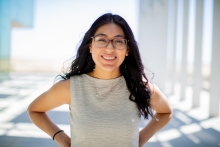 |
Major: Cognitive Science
Home City: Bakersfield, CA
Contact: asantoyo2@ucmerced.edu
Faculty Mentor: Ramesh Balasubramaniam
|
Alex Santoyo is a fourth-year from Bakersfield, CA. Alex is majoring in Cognitive Science, B.S. and is expected to graduate in Fall 2019. Alex has been part of Pre-Law Society, Ingenieros Unidos, Ohana, Sigma Theta Psi Multicultural Sorority, Cognitive Science Student Association, as well as being part of the Cognitive Mechanic’s Lab under Dr. Chris Kello and working in the Valley Housing Office. In her spare time, Alex likes to paint, listen to music as loud as humanly possible before your ears bleed, read, watch movies, and take pictures of Merced sunsets. Alex would like to pursue her PhD at UC Merced in the future and influence more people to become aware of cognitive science.
Auditory and Visual Rhythm Perception & Synchronization
Alejandra Santoyo, Daniel Comstock, and Ramesh Balasubramaniam, PhD; School of Social Sciences, Humanities, and Arts, University of California, Merced
A number of studies suggest there are multiple timing systems within the brain. Further evidence indicates that the dorsal auditory stream connects the auditory cortex to the motor cortex through the posterior parietal cortex, which plays a role in rhythm perception. This dorsal stream is also involved in visual and tactile rhythm perception, suggesting the idea of a common timing system tied to the motor system. Given the evidence of multiple neural timing systems and the common role of the motor system and dorsal stream in both auditory and visual rhythm perception, we hypothesize that performing a motor synchronization task to a rhythm will modify the neural timing mechanisms involved in rhythm perception in both auditory and visual modalities. To investigate this, electroencephalogram (EEG) was used to record brain wave data while participants were tasked to passively entrain to, and finger tap in synchrony to separate visual and auditory rhythms. Preliminary findings show that the frequency bands of entrainment shift from higher frequencies (beta-band) to lower frequencies (delta-band) over the parietal cortex when subjects synchronize their movements to the visual rhythms. This finding provides further evidence of multiple timing mechanisms involved in rhythm perception and that the mechanisms utilized will shift depending on the task.
Gurbinder Singh
Gurbinder Singh is a Merced resident and is a third-year Microbiology and Immunology Major at the University of California, Merced, planning to graduate in Spring 2019. Gurbinder has always been an avid follower of biology and chemistry, and once in high school, he began the path to pursue a career in healthcare. After high school, his objective to pursue a career in healthcare and especially research was strengthened and given direction. To elaborate, Gurbinder found enjoyment in volunteering with the sick and homeless of Merced, and conducting bench research. It was through the involvement in these experiences that Gurdinder ultimately decided that whatever career he will pursue in life, he would be appreciative if he is able to contribute to the Central Valley as it has contributed to him. Outside of the academic world, Gurbinder loves to workout, read works of Stephen King, and is actually quite the garage mechanic.
The Efficacy of Antimicrobial Blue Light on C. albicans Biofilm
Gurbinder Singh, and Clarissa Noble, PhD; School of Natural Sciences, University of California, Merced
Candida albicans is a normal commensal of the human microbiota, but it is also one of the most common fungal pathogens of humans. The most serious C. albicans infections occur in immunocompromised individuals and in patients with medical devices. One facet that makes C. albicans and other fungal microbes more complicated to combat compared to bacteria is that, like humans, they are also eukaryotes. As such, the extensive repertoire of antibiotics that we have developed does not work against fungi, and the few existing classes of antifungals have high human toxicity. Furthermore, C. albicans can form complex and drug resistant biofilms that make C. albicans particularly challenging to treat. Here, we test the efficacy of an alternative therapeutic, antimicrobial blue light therapy, against C. albicans biofilm development. Short-term blue light therapy does not cause damage to human cells, however there is some evidence that it may have antimicrobial properties. We utilize three different in vitro biofilm assays to assess the effects of blue light therapy on C. albicans biofilms. Our findings indicate that blue light therapy can induce a significant reduction in biofilm thickness when used during the first 24h of biofilm formation. These results suggest that blue light therapy may be useful as an alternative antifungal agent.
Angelica Soza
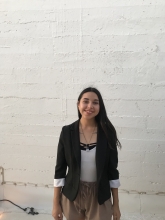 |
Major: Cognitive Science and Psychology
Home City: Merced, CA
Contact: asoza@ucmerced.edu
Faculty Mentor: Jeffrey Gilger
|
Angelica Soza is a fourth-year undergraduate at the University of California, Merced double majoring in Cognitive Science and Psychology. Angelica immersed herself into undergraduate research after her freshman year and has worked in both cognitive science and psychology labs; she is a current research assistant for the Consortium for Research on Atypical Development and Learning (CRADL) under the direction of Jeffrey Gilger where her focus is in cognitive psychology, development, language, and atypical disorders. Angelica is also active in the Merced community as she is involved in multiple extra curricular organizations such as Alliance with Animals, Democrats Club, Young Artist Movement, and she is the host of Merced Coffee Bandit's Open Mic Nights. After graduation she will pursue a PhD in either cognitive science or psychology in order to become a speech pathologist and/or continue researching.
Music Makes You Smarter: Impacts of Music on Academic Performance in School Aged Children
Angleica Soza, Alexander Khislavsky, Meaghan Altman, and Jeffrey Gilger, PhD; School of Social Sciences, Humanities, and Arts, University of California, Merced
Structured activities combining intrinsic motivation and purpose have been found to promote positive academic and social outcomes in young children. Evidence also shows that unstructured activities amongst children led to lower social interaction. The long-standing claim that “Music makes you smarter” has mixed results to support it; the gap in the literature is that most evidence to support this hypothesis is correlational, very few of the studies are longitudinal, and young children are rarely subjects. This study analyzes the NCES ELCS K-4 dataset and uses mixed model repeated measures ANOVAs to evaluate the impact of participation in music influence outcomes longitudinally. Annual participations in musically engaging extracurricular activities served as the between groups independent variables. Performance on measures of math and social skills, over time, were the outcome measures. Biological sex of volunteers was used between-groups covariate in the ANOVA. Analyses revealed that over time there is a moderating effect of math exposure on children’s math performance and ability. Results show differences in math scores depending on how much music exposure a child received and further analyses show differences between biological sex and math performance. These results can help support why children should have exposure to extracurricular activities in order to assist in development.
Stacy Tletlepantzi
Stacy Tletlepantzi is a fourth-year undergraduate student from San Jose, CA. She will be graduating in the spring of 2020 with a BS in Biology and a minor in Spanish. Besides being a student, she is a member of Students Advocating for Law and Education and was part of the scholarship committee for two years. Because she is interested in working with the community, she is a member of Phi Delta Epsilon. Currently, she is working with her Spanish professor on a program named Medical Spanish Service Learning Project. This program aims to allow bilingual students to learn about health disparities in Merced and inform the community about these issues. On her free time, she enjoys going hiking or being at the gym. Once she graduates, she plans to obtain her Ph.D. and be able to give back to her community.
Mineralocorticoid Receptor (MR) Antagonism in the Renin-Angiotensin-Aldosterone System Temporarily Reduces Hypertension
Stacy Tletlepantzi, Ruben Rodriguez, PhD, Manuel Cornejo, PhD, and Rudy Ortiz, PhD; School of Natural Sciences, University of California, Merced
According to the Centers for Disease Control and Prevention, 75 million people have a high systolic blood pressure, including children. Many factors contribute to the development of high blood pressure, among the primary factors is the inappropriate activation of the renin- angiotensin- aldosterone system (RAAS). Inappropriate activation of the RAAS increases sodium reabsorption in the kidneys, however, whether the increase of sodium reabsorption correlates with hypertension is not known. Therefore, we hypothesize Ang II induced rats increases systolic blood pressure, except when a mineralocorticoid receptor (MR) antagonist is present. To test this hypothesis, we measured Na+ and K+ excretion at various times in the following groups of Sprague- Dawley rats: (1) control, (2) angiotensin II infused (Ang II; 80 ng/min x 28 days), (3) Ang II + angiotensin receptor blocker (ARB), (4) Ang II + mineralocorticoid receptor blocker (Epl), and (5) Ang II + ARB + Epl (combo). Once the urine levels are tested, our expected results should demonstrate low excretion of Na+ and high levels of K+ in Ang II infused rats. In the presence of ARB, high levels of Na+ will be excreted than K+. The same results are expected for Epl and ARB + Epl groups. Epl treated rats will exhibit reduced amounts of Na+ reabsorption which will temporarily reduce systolic blood pressure in Ang II infused rats.
Luis Torrijos
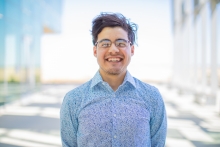 |
Major: Mechanical Engineering
Home City: McFarland, CA
Contact: ltorrijos@ucmerced.edu
Faculty Mentor: Jian-Qiao Sun
|
Luis Torrijos is a third-year undergraduate student from McFarland, CA. He is expected to graduate in Fall 2019 with a BS in Mechanical Engineering and Applied Mathematics minor. Out of the ordinary, he has led the Engineering Service Learning team, Get S.E.T, for one semester. As Project Manager, Luis oversaw assigning tasks to other team members to design 3 plate tectonic boundary models for elementary school students. He worked with the M.E.S.A. lab team, Swarm, to prototype a “Low Cost Obstacle Detection System.” As an Engineer, Luis believes that while conducting research and designing devices the easiest way is often the best. He understands that communication with community partners such as teachers, inventors (Dr. Chen), and colleagues from different fields is key to complete a project and publicize the results. To keep his cool, Luis plays soccer, goes to Yosemite with friends, reads books in Spanish, educates himself about the economy, and listens to music. He is constantly looking for new hobbies such as learning how to play the guitar. Luis has learned that Mechanical Engineering overlaps with the Electrical Engineering and Computer Science fields by getting involved in AIAA’s DBF team. By familiarizing himself with other engineering branches he will be able to collaborate with colleagues to create great things and become a role model to other students.
Turbulence in Cross-Flow Generated by 2 Stage Compressors
Luis Torrijos, Adrian Villegas, and Jian-Qiao Sun, PhD; School of Engineering, University of California, Merced
A two-stage air compression method capable of creating turbulent flow resulting from crossflow is developed for the application of crashing agglomerations of nanoparticles. Turbulence can be beneficial in some applications and hazardous in others. In the present application, turbulence will create random collisions of agglomerations and help nanoparticles mix well with air to form fine mist for application in the agricultural and food industry. Our design comprises a storage unit, 2-stage centrifugal compressors that mimic aircraft engine design, split diaphragms that guide the air flow from one compressor to the other, a chamber of heating rods that serve the purpose of heating the air and creating turbulent flow.
Debora Villalvaza
Debora is a third-year undergraduate student expected to graduate from the University of California, Merced in Spring 2020 with a BA in Political Science and a minor in Economics. Debora is involved on campus with the Business Society and UROC through participating in research over the summer of 2018. Debora aspires to attend law school and focus her time on helping underrepresented groups. In the future, she plans on creating her own non-profit organization to assist underrepresented groups in local communities throughout California. Debora's life accomplishment is attending UC Merced as she is the first person in her family to attend a university; setting a tangible example to her family and community members back in Stockton, CA.
The immigration Legislation Context for Immigration Detention and Family Separation
Debora Villalvaza, and Ma Vang, PhD; School of Social Sciences, Humanities, and Arts, University of California, Merced
Immigration within the U.S. regarding refugees, asylum seekers, and immigrants is a complicated and controversial issue. Given the previous policies, laws, acts, and executive orders enacted by the state, the U.S. government deals with immigration in a negligent, dehumanizing manner. The history of government management of immigration contains serious issues, such as the criminalization and fear of deportation for refugees and immigrants, the lack of sufficient health care, the difficult process of navigating through the legal system, and the separation of families. Through analyzing immigration legislations such as the Supreme Court Case, Reno v. Flores and a Congressional hearing titled Crossing the Border: Immigrants in Detention and Victims of Trafficking Part I and II, this paper shows the systematic difficulties in place affecting immigrants. This study finds that many immigration legislations have a detrimental effect on immigrants, such as health care, time spent in detention, and the separation of families. It is crucial to understand the impact of such legislations, especially over time within the U.S.in order to improve humanitarian and legal conditions regarding immigrants.
Alondra Wences
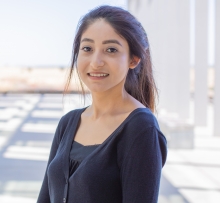 |
Major: Cognitive Science
Home City: Corcoran, CA
Contact: awences2@ucmerced.edu
Faculty Mentor: Ramesh Balasubramaniam
|
Alondra Wences is a fourth-year undergraduate student from Corcoran, CA. Expected to graduate in Spring 2019 with a B.S. in Cognitive Science, Alondra has already begun to make her mark at the University of California, Merced by being an active member on campus. As a learning assistant for P.A.L.S., Alondra thinks it is important to help guide her peers toward success in their academic works; she helps by providing one-on-one tutoring to those who seek assistance in writing. Alondra also serves as a research assistant for the Sensorimotor Neuroscience Laboratory, where she has learned to assist in the planning, designing, and execution of gamified virtual reality experiments. These experiments are geared toward determining factors that help facilitate motor learning in human subjects. To destress, Alondra finds herself painting and going on trips with her siblings. She aspires to achieve a Master's and PhD in neurodegenerative diseases, and her ultimate goal is to develop new therapies for patients with Parkinson's Disease.
World Learning in Virtual Reality: The Effects of Space on Novel Word Learning
Alondra Wences, Timothy M. Shea, Chelsea L. Gordon, and Ramesh Balasubramaniam, PhD; School of Social Sciences, Humanities, and Arts, University of California, Merced
Sensorimotor interaction enables language learning and is assumed to serve as a basis for conceptual representations. However, there is a need of support for the early stages of embodied word learning. To address this, a gamified word learning experiment was developed in virtual reality. Participants learned the names of six novel objects with distinct colors and shapes by interacting with them while facing a set spatial direction; half of the objects could be manipulated with the left hand, and the other half with the right. Through trial and error, participants learned the object names. Afterwards, a word-color match task was completed. There were 4 blocks, half being completed facing the same direction in which the words were learned and the other half being completed facing the opposite direction. We expect to find that when facing the same direction as that during learning, participants will respond more quickly to right-hand words with their right hand. When rotated, however, participants will be quicker to respond to left-hand words with their right hand. This may suggest that the position of the body plays an important role when it comes to the early stages of embodied language learning. Moreover, this may support theoretical views of language that focus on sensorimotor experiences being a foundation for word representations.
Dong Sen (Ricky) Yan
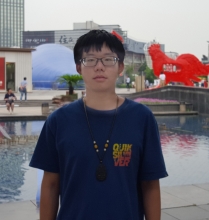 |
Major: Applied Math
Home City: Riverside, CA
Contact: dyan4@ucmerced.edu
Faculty Mentor: Yanquen Chen
|
Ricky Yan is a rising junior undergraduate student from Riverside, CA. Expected to graduate in Spring 2020 with a BS in Applied Math. During his second year in University of California, Merced, he has made his mark by serving as delegate at Inter Club council and being an active member of Rotaract Club. He aspires to achieve a PhD in Applied Math, and his goal is to become a researcher at a National Lab. Some hobbies include reading books, playing tennis, and photoshop.
Unmanned Ground Vehicle for Water Leaking Detection
Ricky Yan, Teibiao Zhao, Haoyu Niu, and YanQuen Chen, PhD; School of Natural Sciences, University of California, Merced
The Unmanned Ground Vehicle is considerable the next generation of agricultural gadgets. Rather than using archaic method to manually search for leaks, my project is aiming to replace past archaic method. Utilizing multiple dynamic image-processing techniques like optical flow, Gaussian Mixture Model, and computer vision to detect pipe leak. From all above method, optical flow is the most efficient and accurate. The result of the project will be placed on UGV and autonomously navigate through way-point by Mission Planner and the PixHawk Autopilot System.
